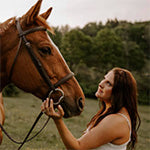A horse’s dietary needs are not set in stone year-round. When the seasons change, your horse’s dietary needs may need to change, too. These changes might be minor tweaks, but for some horses, their winter versus summer diets look very different.
This is because, in the summer, horses that are turned out on pasture are often consuming more forage, and therefore, more calories and nutrients than what they would get from their forage in the winter.
Here is what you need to know about your horse’s dietary needs and how they might change each season.
Spring and Summer Diet Considerations for Horses
As winter gives way to spring, especially once horses are being put out on fresh spring grass, it’s time to re-evaluate their dietary needs.
Being mindful of your pastures, how the grass looks, and how it’s being consumed by your horses is important. Always introduce horses to this new grass slowly, and start with short grazing sessions, or use a grazing muzzle on your horse.
This will prevent the issues that we also see in the fall, like triggering colic or laminitis episodes that are associated with abrupt diet and sugar changes since the sugar and nutrients in the grass increase in the spring.
While the spring grass is still lush and they are slowly transitioning, it’s important to continue providing quality hay and a balanced horse feed or ration balancer. You can then slowly adjust the amount of hay versus grazing time as the season progresses.
It’s also important to assess your horse’s feed requirements around this time based on their age, activity level, health concerns, etc. For example, once an easy keeper is on summer grass, they may need to be switched to a ration balancer.
As horses shed their coats in the spring, this is a great time to assess their overall body score and adjust their grain intake accordingly.
Nutrition plays a role in seasonal shedding as well. Low dietary levels of certain nutrients can affect how quickly and the quality of a horse’s shedding.
For example, amino acids and protein deficiencies can cause slow shedding. Omega 3 and 6 fatty acids found in fresh pastures can help improve a horse’s hair quality and the shedding process during this transitional time.
Adding omega fatty acids to your horses diet, such as those in Wholesome Blends Omega Plus Oil, can help with this coat transition. As a bonus, it can help improve body condition in horses who may look a bit thin coming out of the winter months.
Fall and Winter Diet Considerations for Horses
The shifts in forage quality and requirements are significant starting in the fall. This is due to the change in temperature, which affects the pastures because it starts becoming too cool for plants to grow, and in turn, the sugars are stored in the plants for later use.
This leads to a more concentrated storage of sugars in the plants horses eat. For horses who are overweight, have sugar sensitivities, and those with laminitis risks especially, this is an important consideration. This shift in the plant’s concentration of sugars can also lead to digestive upset for some horses. Many times, this weather change has also been known to cause an increase in colic episodes.
The lack of grass in the pastures means owners should begin increasing the amount of high-quality hay fed moving into the winter months.
Some of the ways you can tell forage is high-quality is its smell and color. It should smell fresh and not smell musty or moldy, have a high leaf-to-stem ration, and a bright color that is not yellow, brown, or faded looking.
The plant’s maturity at the time of harvest will also determine its quality. If the plant was leafy and young when harvested, its likely to contain more protein, minerals, and energy. Older plants, when harvested, have thicker stems, more indigestible fiber, and are not as nutrient dense. Hay can also be lab tested for quality, if you are ever unsure.
Horses will need to be supplemented with high-quality horse feed or ration balancers so they maintain good body condition and health throughout the winter months. This is especially important when feeding lower quality forage.
Feeding more hay in the winter, especially feeding a few small forage meals throughout the day, is also a great way for horses to naturally keep warm, assist with natural grazing behaviors, and fight off boredom with more time in their stalls.
However, when switching from pasture grass to hay or when getting a new supply of hay that might be a different quality, this should also trigger a change in the horse’s grain intake and the use of ration balancers. This change should also be made gradually to prevent digestive upset.
For horses on a diet of 50% or more alfalfa, consider a ration balancer specifically designed for this, such as Alfa Essentials®, which is low in sugar and starch with no added iron. It is designed for easy keepers or to be added as a top-dress with regular grain.
For horses transitioning to a hay that is 50% or more grass (therefore, less than 50% alfalfa), a ration balancer like Essential K® is ideal.
Ration balancers are also great for ensuring horses are getting the proper vitamins and minerals they might be lacking, or for use in horses who are easy keepers that don’t need a lot of grain.
Many horses are also less active in the winter, so calorie input versus output when considering how much grain to feed should also be considered and discussed with your veterinarian.
Adjusting horse feed rations and planning ahead in the fall with forage will help prevent weight loss and some of these other winter-related health concerns.
If you have questions about your horse’s nutrition plan, please reach out to us for a free, personalized feeding plan.

